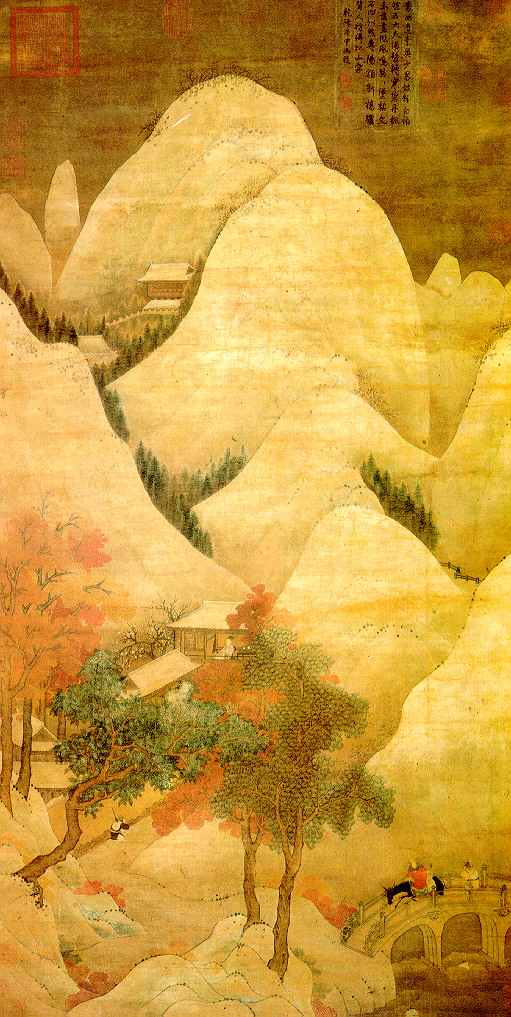User:Chen Junyu/Graduation Project Seminar/ project proposal/Proposal6: Difference between revisions
Chen Junyu (talk | contribs) |
Chen Junyu (talk | contribs) No edit summary |
||
| Line 36: | Line 36: | ||
Chinese landscape painting can be traced to Jin Dynasty(3 to 4th century), it is the epoch which has the most free spirit and liberative mind. | Chinese landscape painting can be traced to Jin Dynasty(3 to 4th century), it is the epoch which has the most free spirit and liberative mind. | ||
==Literature Survey== | |||
Philip Rawson, ''Drawing'' | |||
Fritz van Briessen The Way of the Brush: Painting Techniques of China and Japan | |||
Xie He ''Six principles of Chinese painting 古画品录'' | |||
Lu Hong, ''The Formation and Development of New Ink Art in China'' http://www.mplusmatters.hk/inkart/paper_topic2.php?l=en | |||
Zhu Qi, "Natural and abstract form and the unfinished modernism of Chinese painting" http://www.artlinkart.com/cn/article/overview/b55cvCso | |||
Zong baihua,"Thoughts of <A New Account of the Tales of the World> and the beauty of Jin Dynasty" | |||
Revision as of 14:07, 26 January 2015
Question
By which way, I could approach the core in my work that Chinese painting always chases for--resonance of the spirit,movement of life.
Context
Here is a story about the great Chinese painter Zhang Sengyou (Chinese: 张僧繇). Quoted from Fritz Van Briessen's The Way of the Brush, originally written by Zhang Yanyuan from Tang Dynasty:
Zhang one day decided to paint a dragon on the wall of his house. He guided his brush with full confidence, and after a while the dragon was finished except for its eyes. Suddenly the master's courage failed him. He simply did not dare to paint those eyes. When, many months later, he at last felt brave enough, he groped for his brush and with swift strokes dashed in eye and pupil. Within an instant the dragon broke into cloud roaring and flew away, leaving a trace of fire and smoke.
In the Asiatic world, belief in the supernatural power of the artist remained alive over greatly prolonged period. And there was no absolute division between magic, religion and philosophy in the east, especially in China. Taoism, as the primitive Chinese philosophy for the Han race, effects the developing of Chinese painting on a fundamental base. It influences the establishment of the material system and the construction of the painting principles.
The generally accepted principle for Chinese painting was written by Hsieh Ho,a writer, art historian and critic in 6th century China, named as The Six Principles of Hsieh Ho. He summarized six sentences to divide the different level of paintings. There are different versions of the interpretation in English of the six principles, and all of them are so contrasting, here I use the translation of Osvald Siren's Early Chinese Painting, which I think it is the closest one to the original version.
The six principles of Chinese painting:
1) Resonance of the spirit; Movement of Life.
2) Bone Manner (i.e. Structural) Use of the Brush.
3) Conform with the objects ( to obtain ) their Likeness.
4) According to the Species, apply the Colours.
5) Plan and Design; Place and Position ( Composition)
6) To transmit Models by Drawing.
In Hsieh Ho's principles, the achievement of resonance of the spirit/movement of life is the standard that if a painting reaches the highest level. The transmition of model by drawing is the requirement for the lowest level of Chinese painting. That is to say, the representational depiction in Chinese painting is not the most important factor, it can be the provement of the painter's technique. Only when a painting transmit the lively spirtual of what the painter wants to express, the authenticity behind the surface,this painting can be judged as one of the best category.
The Abstraction of Chinese landscape painting and the possible relation with Dutch( Western) painting
From Modrian to American exprssion, abstraction art has near 100 years history. But since 4th century, there has already existed abstraction in Chinese painting - it is not purely formalism as neoplasticism, the figure of object is still depicted in the painting, some painters started pursuing the expression of their feeling and spirit by the changing of the usage of the ink, brush. Just more or less at the same time, Hiesh Ho proposed his six principle of Chinese painting. His idea of how to consider when judge a painting also suggests the importance of expressing the invisible real existence behind the object in Chinese painting.
Chinese landscape painting can be traced to Jin Dynasty(3 to 4th century), it is the epoch which has the most free spirit and liberative mind.
Literature Survey
Philip Rawson, Drawing
Fritz van Briessen The Way of the Brush: Painting Techniques of China and Japan
Xie He Six principles of Chinese painting 古画品录
Lu Hong, The Formation and Development of New Ink Art in China http://www.mplusmatters.hk/inkart/paper_topic2.php?l=en
Zhu Qi, "Natural and abstract form and the unfinished modernism of Chinese painting" http://www.artlinkart.com/cn/article/overview/b55cvCso
Zong baihua,"Thoughts of <A New Account of the Tales of the World> and the beauty of Jin Dynasty"


